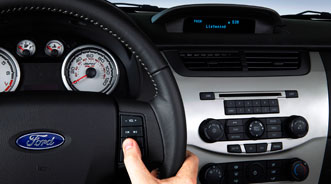Ford’s SYNC to Cover 19 Languages

Ford recently announced it’s expanding the reach of its voice-controlled connectivity system SYNC as the automaker stretches its vehicle lineup through Europe.
The company contends its technology now will be available in more languages than any other automaker offering voice control as both SYNC and MyFord Touch now can come in 19 languages, including:
—U.S. English
—U.K. English
—Australian English
—European French
—Canadian French
—European Spanish
—U.S. Spanish
—European Portuguese
—Brazilian Portuguese
—German
—Italian
—Dutch
—Russian
—Turkish
—Arabic
—Korean
—Japanese
—Mandarin Chinese
—Taiwanese Mandarin (supported through Mandarin Chinese)
Ford president and chief executive officer Alan Mulally insisted the expansion brings the convenience of SYNC to a much larger audience of potential customers. Mulally discussed the developments during the 2011 CeBIT Technology Show in Hanover, Germany.
“We are pleased to announce that SYNC will soon be available to customers around the world,” Mulally stated. “It is a smart and simple way to connect drivers with in-car technologies and their digital lives.”
Ford originally launched SYNC in North America back in 2007 with three languages. The automaker indicated the Ford Focus will be the first vehicle to launch with SYNC in Europe next year.
How a Vehicle Can Speak
At the heart of SYNC is the speech engine, and the automaker is working with its speech technology partner Nuance Communications to deliver a similar experience across the multiple languages.
The OEM explained that it leverages significant investments made by Nuance to support the broad dialect coverage required in larger regions such as the United States. Additionally, officials contend regions such as Europe present unique challenges, in part because of the proximity of different countries and the resulting need for multilingual solutions.
For the customer, Ford said that means SYNC can recognize 10,000 voice commands in any one of the available 19 languages, and can cope with variances in accents, vocabulary and local dialects.
“If a German customer, for example, is driving in Italy, the system can provide directions in German but will use the correct Italian pronunciation for street names,” Ford offered.
Furthermore within each international market, Ford noted a unique set of abbreviations for text messaging also has been identified. For example, the company mentioned “cvd,” short for “Ci vediamo dopo,” was added for SYNC to read aloud, which basically means “See you later” in Italian.
“We had to make sure the system would behave as people expect in different countries and different cultures,” stated Mark Porter, supervisor of SYNC Product Development.
“That means we had to solicit local, native-speaking input for common abbreviations used in SMS messages as well as support different units of distance and date formats,” Porter continued.
Ford found song titles and artist names posed further challenges.
The company learned that a German owner, for instance, may have songs by artists of German, American, Spanish and other nationalities on an MP3 player. Due to phonetic differences between the languages, Ford insisted the system must be able to recognize a name whether it’s pronounced in German or deep Southern American English.
“The in-car experience needs to be global in nature, supporting a variety of languages to ensure all commands, addresses and song titles are recognized, whether you’re from Germany, Portugal or France. Localization should not equal limitations,” explained Arnd Weil, vice president of Nuance Automotive.
“Working closely with Ford, we’ve customized the SYNC experience across multiple languages to ensure drivers in all regions experience the simplicity and convenience that in-car voice technology has to offer,” Weil went on to say.
Software, Rather Than Hardware Solutions
As with many SYNC advancements over the years, Ford thinks the expanded language capabilities can leverage the system’s flexible, software-based platform for a cost-effective and efficient solution.
Using a single, common hardware module equipped with Wi-Fi, the automaker believes SYNC can be easily configured for language on the assembly line. An on-the-line server can connect with the SYNC module wirelessly, determines the appropriate software installation — including language — and can download the information to the vehicle.
Moreover, the manufacturer pointed out using a common module and Wi-Fi installation can avoid the logistics of stocking unique modules with every possible combination of language and capability offered by SYNC. In fact, Ford said it would have had to produce more than 90 different hardware modules to accommodate all of the different languages installed at assembly plants around the world.
Future of In-Vehicle Voice Communication Interfaces
With independent research firms such as Datamonitor predicting that advanced speech recognition in the mobile world will triple by 2014 with similar growth for speech recognition in vehicles, Ford believes that it’s ahead of the curve with the SYNC global language expansion plan.
“Ford is committed to making voice recognition the primary user interface inside the car throughout the world, helping all drivers keep their eyes on the road and hands on the wheel,” noted Jim Buczkowski, a Henry Ford Technical Fellow and director of Electrical and Electronics Systems for Ford Research and Advanced Engineering.
“This expansion of SYNC language capabilities is a huge step forward in bringing voice technology to every market Ford serves,” Buczkowski concluded.

 View The Latest Edition
View The Latest Edition

